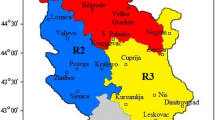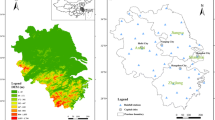Abstract
This study presents a comprehensive Regional Frequency Analysis (RFA) of maximum 5-day precipitation totals (Rx5D) in Slovakia using the L-moments approach. The analysis utilized data from 419 precipitation stations across Slovakia, operating continuously from 1951 to 2020. The main objectives were to identify homogeneous regions based on Rx5D, estimate regional frequency distributions, calculate maximum Rx5D for return periods of 5, 10, 20, 50, 100, and 200 years, and map these estimates for Slovakia. The cluster analysis, employing index-flood procedure and Ward’s method, identified 14 reasonably homogeneous clusters. Homogeneity and discordancy tests further refined these clusters. The regional frequency distribution for each Rx5D region was determined using L-moment ratio diagrams, \({Z}^{Dist}\) measure and Anderson–Darling tests, resulting in the selection of Gumbel (GUM), Generalized Pareto (GPA), and Generalized Logistic (GLO) as the best-fit distributions for different regions. Specifically, GUM was selected as the best fit only for mountainous regions, highlighting the variability in distribution characteristics across different geographical areas. The analysis revealed significant spatial variability in the Rx5D patterns across Slovakia. Our results indicate that, design Rx5D values expected once every 100 years in lowland regions could occur as frequently as once every 25 years in mountainous areas. The most extreme design Rx5D values exceeding 200 mm were observed in the high-elevation mountainous regions, underscoring the heightened risk of extreme precipitation events in these areas. By exposing these spatial variations, our study contributes to a deeper understanding of precipitation extremes in Slovakia and provides a robust framework for informing water resource management and climate adaptation strategies in the region.




Similar content being viewed by others
Data availability
The data that support the fndings of this study are available from the author [ladislav.markovic@shmu.sk], upon reasonable request.
References
Adamowski K (2000) Regional analysis of annual maximum and partial duration flood data by nonparametric and l-moment methods. J Hydrol 229:219–231. https://doi.org/10.1016/S0022-1694(00)00156-6
Amiri MA, Gocić M (2021) Analyzing the applicability of some precipitation concentration indices over Serbia. Theor Appl Climatol 146:645–656. https://doi.org/10.1007/s00704-021-03743-5
Amiri MA, Mesgari MS (2019) Spatial variability analysis of precipitation and its concentration in Chaharmahal and Bakhtiari province, Iran. Theor Appl Climatol 137:2905–2914. https://doi.org/10.1007/s00704-019-02787-y
Burn DH (1990) Evaluation of regional flood frequency analysis with region of influence approach. Water Resour Res 26:2257–2265. https://doi.org/10.1029/WR026i010p02257
Čeman R (2003) Zemepisný atlas Slovenská republika [Geographical atlas of the Slovak Republic]. 1. Edition. Bratislava: Mapa Slovakia, 2003. 96 pgs. ISBN 80–8067–006–4
D’Agostino RB, Stephens MA (1986) Goodness-of-fit techniques. Dept. of Stat. S. Methodist Univ, Dallas, Tex
Dalrymple T (1960) Flood frequency analysis. Manual of hydrology: Part 3. Flood-flow techniques. Water Supply Paper 1543-A. United States Geological Survey, Reston, VA, 80 pp. https://doi.org/10.3133/wsp1543A
Dezfuli AK (2011) Spatio-temporal variability of seasonal rainfall in western equatorial Africa. Theor Appl Climatol 104:57–69. https://doi.org/10.1007/s00704-010-0321-8
Dinpashoh Y, Fakheri-Fard A, Moghaddam M, Jahanbakhsh S, Mirnia M (2004) Selection of variables for the purpose of regionalization of Iran’s precipitation climate using multivariate methods. J Hydrol 297:109–123. https://doi.org/10.1016/j.jhydrol.2004.04.009
ESRI (2011) ArcGIS Desktop: Release 10.3.1. Redlands, CA: Environmental Systems Research Institute
Fovell R, Fovell MYC (1993) Climate Zones of the Conterminous United States Defined Using Cluster Analysis. J Clim; (United States) 6:11. https://doi.org/10.1175/1520-0442(1993)006<2103:CZOTCU>2.0.CO;2
Gaál L, Lapin M (2002) Extreme several-day precipitation totals at the Hurbanovo observatory (Slovakia) during the 20th century. Contrib Geophys Geod 32(3):197–213
Gaál L (2004) Regionálna frekvenčná analýza ročných maxím jednodenných úhrnov zrážok vo vybraných oblastiach Slovenska - Experimenty s klastrovou analýzou [Regional frequency analysis of annual maxima of one-day rainfall totals in selected areas of Slovakia - Experiments with cluster analysis]. In Conference proceedings - International Bioclimatological Workshop „Climate Change 199 - Weather Extremes - Organisms and Ecosystems", Slovak Agricultural University, Nitra. 13 pp., ISBN 80–8069–402–8
Gocic M, Velimirovic L, Stankovic M, Trajkovic S (2021) Regional precipitation-frequency analysis in Serbia based on methods of L-moment. Pure Appl Geophys 178. https://doi.org/10.1007/s00024-021-02688-0
Greenwood JA, Landwehr JM, Matalas NC, Wallis JRM (1979) Probability weighted moments: Definition and relation to parameters of several distributions expressable in inverse form. Water Resour Res 15(5):1049–1054. https://doi.org/10.1029/WR015i005p01049
Guttman NB (1993) The use of L-moments in the determination of regional precipitation climates. J Climatol 6:2309–2325. https://doi.org/10.1175/1520-0442(1993)006<2309:TUOLMI>2.0.CO;2
Haddad K, Rahman A, Green J (2010) Design rainfall estimation in Australia: A case study using L-moments and generalized least squares regression. Stoch Env Res Risk A. https://doi.org/10.1007/s00477-010-0443-7
Hosking JRM (1992) Moments or L moments? An example comparing two measures of distributional shape. Am Stat 46(3):186–189. https://doi.org/10.2307/2685210
Hosking JRM (1995) The use of L-moments in the analysis of censored data. In: Balakrishnan N (ed) Recent advances in life-testing and reliability. CRC Press, Boca Raton, pp 545–564
Hosking JRM, Wallis JR (1993) Some statistics useful in regional frequency analysis. Water Resour Res 29:271–281. https://doi.org/10.1029/92WR01980
Hosking JRM, Wallis JR (1997) Regional frequency analysis. Cambridge University Press, 224 pp. https://doi.org/10.1017/CBO9780511529443
Hosking JRM (1990) L-moments: analysis and estimation of distributions using linear combinations of order statistics. J R Stat Soc Ser B 52(1):105–124. JSTOR 2345653. https://doi.org/10.1111/j.2517-6161.1990.tb01775.x
Hosking JRM (2019) Regional frequency analysis using L-moments. R package, version 3.3. URL: https://CRAN.R-project.org/package=lmomRFA. Accessed 10 Jan 2014
Isik S, Sinhgh VP (2008) Hydrologic regionalization of watersheds in Turkey. J Hydrol Eng 13. https://doi.org/10.1061/(ASCE)1084-0699(2008)13:9(824)
Jain AK, Murty MN, Flynn PJ (1999) Data clustering: A review. Acm Comput Surv (Csur) 31:264–323. https://doi.org/10.1145/331499.331504
Jurčová S, Kohnová S, Szolgay J, Gaál L (2002) K výberu vhodnej distribučnej funkcie maximálnych 5-denných úhrnov zrážok [Selection of a suitable distribution function of maximum 5-day rainfall totals]. Acta Hydrol Slovaca 3(2):165–173
Kar KK, Yang SK, Lee JH (2017) Regional frequency analysis for consecutive hour rainfall using L-moments approach in Jeju Island, Korea. Geoenviron Disasters 4:18. https://doi.org/10.1186/s40677-017-0082-0
Kottegoda NT, Rosso R (1997) Statistics, probability, and reliability for civil and environ-mental engineers. McGraw Hill International Editions, New York, pp 216–217
Květák Š (1983) Príspevok ku kontinentalite podnebia na Slovensku [Contribution to the continentality of the climate in Slovakia]. In: Zborník prác Slovenského hydrometeorologického ústavu. ALFA, Bratislava, 95 – 135
Kyselý J, Picek J (2007) Regional growth curves and improved design value estimates of extreme precipitation events in the Czech Republic. Climate Res 33(3):243–255. https://doi.org/10.3354/cr033243
Laio F (2004) Cramer-von Mises and Anderson-Darling goodness of fit tests for extreme value distributions with unknown parameters. Water Resour Res 40:W09308. https://doi.org/10.1029/2004WR003204
Lapin M, Gaál L, Faško P (2004) Maximálne viacdenné úhrny zrážok na Slovensku [Maximum multi-day rainfall totals in Slovakia]. Seminár „Extrémy počasí a podnebí “, Brno. ISBN 80–86690–12–1
Lapin M, Tomlain J (2001) Všeobecná a regionálna klimatológia [General and regional climatology]. Comenius University Publishing, Bratislava (ISBN 80-223-1433-1)
Malekinezhad H, Nachtnebel HP, Klik A (2011) Regionalization approach on extreme flood analysis using L-moments. J Agr Sci Tech 13:1183–1196
Malekinezhad H, Zare GA (2014) Regional frequency analysis of daily rainfall extremes using L-moments approach. Atmósfera 229. https://doi.org/10.1016/S0187-6236(14)70039-6
Markovič L, Faško P, Pecho J (2021) Climatology of the extreme heavy precipitation events in Slovakia in the 1951–2020 period. Acta Hydrol Slovaca 22(2):294–303. 2644–6291 (printed until 2018). https://doi.org/10.31577/ahs-2021-0022.02.0033
Markovič L (2017) Analýza maximálnych dvojdenných a päťdenných úhrnov atmosférických zrážok na území Slovenska v období 1951–2010. [Analysis of the maximum 2-day and 5-day precipitation totals in Slovakia in the period 1951 – 2010] Master thesis. Faculty of mathematics, physics and informatics, Comenius university, Bratislava, Slovakia. pp 73
Markovič L (2019) Dynamic-climatological analysis of the maximum 2-day precipitation totals in Slovakia. Meteorologický časopis. Bratislava: Slovenský hydrometeorologický ústav 22(1):31–38. ISSN 1335–339X
Melo M, Lapin M, Kapolková H, Pecho J, Kružicová A (2013) Climate trends in the Slovak part of the Carpathians. In: Kozak J, Ostapowicz K, Bytnerowicz A, Wyzga B (eds) The Carpathians: Integrating nature and society towards sustainability. Environmental Science and Engineering. Springer, Berlin, Heidelberg. https://doi.org/10.1007/978-3-642-12725-010
Mogotsi IC, Manning CHD, Raghavan P, Schütze H (2010) Introduction to information retrieval. Inf Retrieval 13:192–195. https://doi.org/10.1007/s10791-009-9115-y
Nicholson SE, Dezfuli AK (2013) The relationship of rainfall variability in western equatorial africa to the tropical oceans and atmospheric circulation. Part II: The boreal autumn. J Clim 26:45–65. https://doi.org/10.1175/JCLI-D-11-00653.1
Norbiato D, Borga M, Sangati M, Zanon M (2007) Regional frequency analysis of extreme precipitation in the eastern Italian Alps and the August 29, 2003. J Hydrol 345:149–166. https://doi.org/10.1016/j.jhydrol.2007.07.009
Nuñez JH, Verbist K, Wallis JR, Schaefer MG, Morales L (2011) Cornelis WM (2011) Regional frequency analysis for mapping drought events in north-central Chile. J Hydrol 405:352–366. https://doi.org/10.1016/j.jhydrol.2011.05.035
Oliver MA, Webster R (1990) Kriging: a method of interpolation for geographical information systems. Int J Geogr Inf Syst 4(3):313–332. https://doi.org/10.1080/02693799008941549
Peel MC, Wang QJ, Voget RM (2001) Mcmahon TA (2001) The utility of L-moment ratio diagrams for selecting aregional probability distribution. Hydrol Sci J 46:147–155. https://doi.org/10.1080/02626660109492806
R Core Team (2020) R: A language and environment for statistical computing. R Foundation for Statistical Computing, Vienna, Austria. URL https://www.R-project.org/
RamachandraRao A, Srintivas V (2006) Regionalization of watersheds by hybrid-cluster analysis. J Hydrol 318:37–56. https://doi.org/10.1016/j.jhydrol.2005.06.003
Remiášová R, Gaál L, Hlavčová K, Kohnová S, Szolgay J (2011) Priestorová regionalizácia návrhových zrážok na Slovensku [Spatial regionalization of design precipitation in Slovakia]. Ostrava: Key Publishing, 2011. Monografie. ISBN 9788074181092
RStudio Team (2022) RStudio: Integrated development environment for R. RStudio, PBC, Boston, MA. http://www.rstudio.com. Accessed 10 Jan 2014
Schaefer MG (1990) Regional analyses of precipitation annual maxima in Washington State. Water Resour Res 26:119–131. https://doi.org/10.1029/WR026i001p00119
Scholz FW, Stephens MA (1987) K-sample Anderson-Darling tests. J Am Stat Assoc 82:918–924. https://doi.org/10.1080/01621459.1987.10478517
Siman C, Polčák N (2017) Vplyv kontinentality podnebia na vybrané charakteristiky snehovej pokrývky na slovensku v období rokov 1981/82 – 2010/11 [The influence of the continentality of the climate on selected characteristics of the snow cover in Slovakia in the period 1981/82 – 2010/11]. Meteorologický časopis, Vol. 20/1, s. 11 – 18. Available online: http://www.shmu.sk/File/ExtraFiles/MET_CASOPIS/2017-1_MC.pdf. Accessed 10 Jan 2014
Stedinger JR, Vogel RM, Foufoula-Georgiou E (1993) Frequency analysis of extreme events. Chapter 18. In: Maidment DR (ed) Handbook of hydrology. McGraw Hill, New York, 18.1–18.66
Stedinger JR, Lu LH (1995) Appraisal of regional and index flood quantile estimators. Stoch Hydrol Hydraul 9:49–75. https://doi.org/10.1007/BF01581758
Stehlová K, Kohnová, S, Szolgay J (2001) Analýza dvojdňových úhrnov zrážok v oblasti horného Hrona, Acta Hydrologica Slovaca [Analysis of two-day precipitation totals in the upper Hron region]. 2(1):167–174
Sveinsson OGB, Boes DC, Salas JD (2001) Population index flood method for regional frequency analysis. Water Resour Res 37:2733–2748. https://doi.org/10.1029/2001WR000321
Velimirovic L, Stankovic M, Gocic M, Trajkovic S (2021) Determining the best fitting distribution of annual precipitation data in Serbia using L-moments method. Earth Sci Inf 14:1–12. https://doi.org/10.1007/s12145-020-00543-9
Viglione A, Laio F, Claps P (2007) A comparison of homogeneity tests for regional frequency analysis. Water Resour Res 43:W03428. https://doi.org/10.1029/2006WR005095
Viglione A (2020) nsRFA: Non-supervised regional frequency analysis. R package version 0.7–15. https://CRAN.R-project.org/package=nsRFA. Accessed 10 Jan 2014
Wallis JR, Schaefer MG, Barker BL, Taylor GH (2007) Regional precipitation-frequency analysis and spatial mapping for 24-hour and 2-hour durations for Washington State. Hydrol Earth Syst Sci 11:415–442. https://doi.org/10.5194/hess-11-415-2007
Ward J (1963) Hierarchical grouping to optimize an objective function. J Am Stat Assoc 58:236–244. https://doi.org/10.1080/01621459.1963.10500845
Funding
This work was supported by the Slovak Research and Development Agency under the Contract no. APVV-19-0340.
Author information
Authors and Affiliations
Contributions
L.M.—Data curation, Writing, statistical analysis, Visualization, Review and editing and P.F.—Data curation, Formal analysis, Review and editing, Supervision. All authors reviewed the manuscript.
Corresponding author
Ethics declarations
Competing interests
The authors declare no competing interests.
Additional information
Publisher's Note
Springer Nature remains neutral with regard to jurisdictional claims in published maps and institutional affiliations.
Rights and permissions
Springer Nature or its licensor (e.g. a society or other partner) holds exclusive rights to this article under a publishing agreement with the author(s) or other rightsholder(s); author self-archiving of the accepted manuscript version of this article is solely governed by the terms of such publishing agreement and applicable law.
About this article
Cite this article
Markovič, L., Faško, P. Regional frequency analysis for maximum 5-day precipitation totals using L-moments approach in Slovakia. Theor Appl Climatol (2024). https://doi.org/10.1007/s00704-024-04970-2
Received:
Accepted:
Published:
DOI: https://doi.org/10.1007/s00704-024-04970-2




